World 🢖 Europe 🢖 United Kingdom 🢖 Jersey
Prehistoric and ancient cemeteries 🢔 Cemeteries 🢔 Archaeological wonders 🢔 Categories of wonders
Wonder
La Hougue Bie
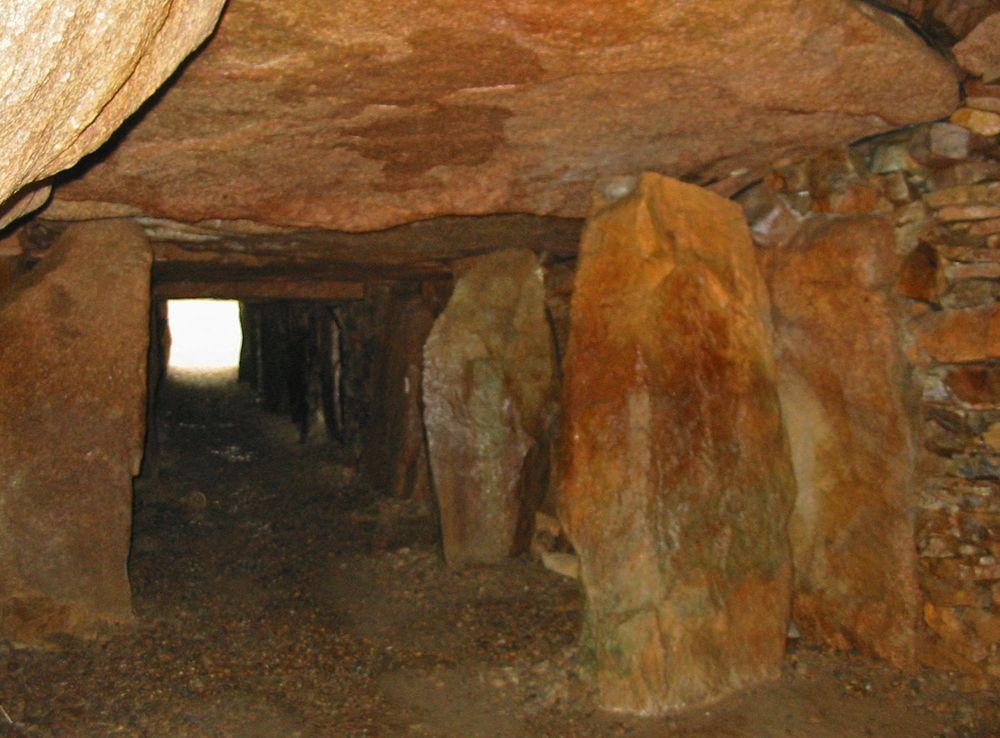
 In short
In short
Highly unusual archaeological monument is La Hougue Bie – enormous, artificial earth mound. It hides 18.6 m long passage lined with enormous stones. This mound and passage in it were made some 6000 years ago – in Neolithic period, around 4000 – 3500 BC. But on the top of this mount are two Medieval chapels. Such an unusual mix of cultural monuments is unique.
 45.8%
45.8%
GPS coordinates
Location, address
Age
Map of the site
If you see this after your page is loaded completely, leafletJS files are missing.
 In detail
In detail
Legend about the dragon
There is a legend about the origin of this enormous mound:
Once upon a time the island of Jersey was terrorized by a dragon. Seigneur de Hambye heard about this calamity and came from Normandy to fight with this dragon. He found the beast and defeated it in a long and strenuous fight. After the desperate fight, Seigneur fell on the ground exhausted and wounded.
His squire murdered the hero. When the traitor returned home, he told that the dragon killed Seigneur and the squire then killed the dragon. Squire told also the final wish of Seigneur was that the squire should marry his widow. Thus the squire took over the possessions of his master.
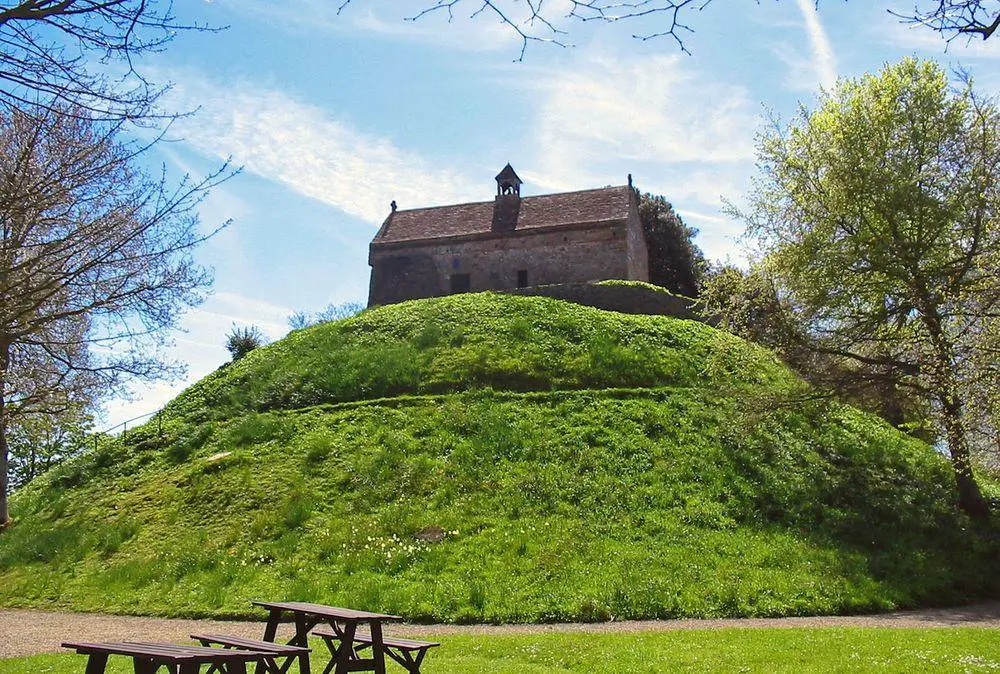
One night though he told the truth to his new wife. The wife immediately ordered to arrest him and the squire was executed.
According to this legend La Hougue Bie is a monument to Seigneur de Hambye built by his wife.
In Jèrriais language the word "hougue" means – mound but "bie" – homestead. Thus the name means: "homestead near the mound". Another explanation though is linked to the legend – this mound was named La Hougue Hambye. Later it was shortened to La Hougue Bie.
Hill with medieval chapels
In medieval times this steep, grass-covered mound was used to build a chapel on the top of it. The first chapel was built around the 12th century. Judging from its location (walls of the chapel are above the walls of passage grave under it), the builders knew about the passage below the church.
Currently on the top of this mound is located one elongated building. This structure is built in the 16th century or later.
In 1792 on the top of the chapel was built a large tower in Neo-Gothic style – so-called Prince’s Tower. The medieval chapel was split into two parts: the western end (the Notre Dame Chapel) was kept as a private chapel but in the eastern end (Jerusalem Chapel) was arranged a library.
Prince’s Tower was demolished in 1924 in order to provide safety for the exploration of the Neolithic passage grave.
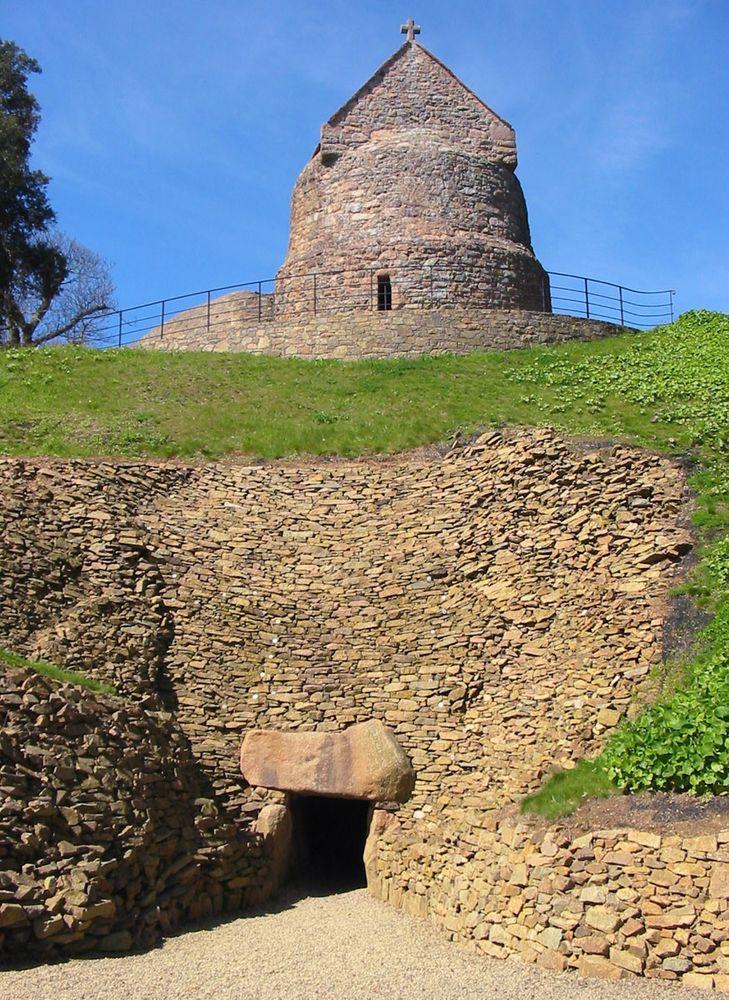
Discovery of Neolithic passage grave
People had the anticipation that this weird, steep mound may hide ancient passages.
In 1924 – 1925 the Société Jersiaise organized the first archaeological excavations of this mound. The entrance in the passage was luckily found already at the first attempt. Before the full exploration, there was needed a repair of the collapsed passage.
Excited explorers entered the ancient passage, lined by giant stone slabs. It is possible that they were the first people to enter this monument in the last 5000 years – although it is possible that some plundering took place in between.
Archaeologists found fragments of 20 vase supports together with scattered remnants of at least eight people – men and women buried here. Some grave goods (mostly pottery) were present – which hints at belief in the afterlife.
More archaeological excavations took place in 1991 – 1996. Then was restored the original, impressive entrance in the passage.
Nowadays the passage grave is available to the public, both chapels above are available too.
Most impressive of Armorican Passage Graves
Megalithic passage graves are grouped by their structure. La Hougue Bie belongs to a group of Armorican Passage Graves, found in the Channel Islands and Brittany. It is not just a member of this group – it is by far the largest and best-preserved of these passage graves.
Diameter of La Hougue Bie is 58 m and it covers almost 2 400 m2. The height of the mound is 12.2 m.
The entrance in the mound is directed to the east. The total length of the passage is 18.6 m. It starts with some 9 m long, narrow passage, where one should crawl through until reaching a larger chamber. This larger chamber has a cruciform shape in the plan.
Passage is covered with enormous roofing slabs. The largest (stone No 69) weighs approximately 20 tons.
Ancient shrine
The earliest history of this exceptional monument most likely is obscured by the later construction works. The oldest datable works took place around 4000 – 3500 BC. Then here was built the inner part of the current passage grave and it was covered with a pile of stones… lots of stones. Total volume of the cairn was approximately 6 300 m3.
Later the passage grave was extended and the cairn increased to 9 000 m3.
Sometimes around 3000 BC the entrance in the passage was sealed and roughly at 2900 – 2500 BC the pile of stones was covered with a thick layer of soil, turning the ancient (ancient already then – 4500 years ago!) shrine into a green hill.
Astronomical orientation
This amazing structure has a specific position: in spring and autumn equinox the Sun shines through the passage at the sunrise. The whole 18.6 m long, narrow passage is lighted up with an eerie, red light.
Such amazing peculiarity shows that La Hougue Bie is not just a graveyard – it is rather a shrine.
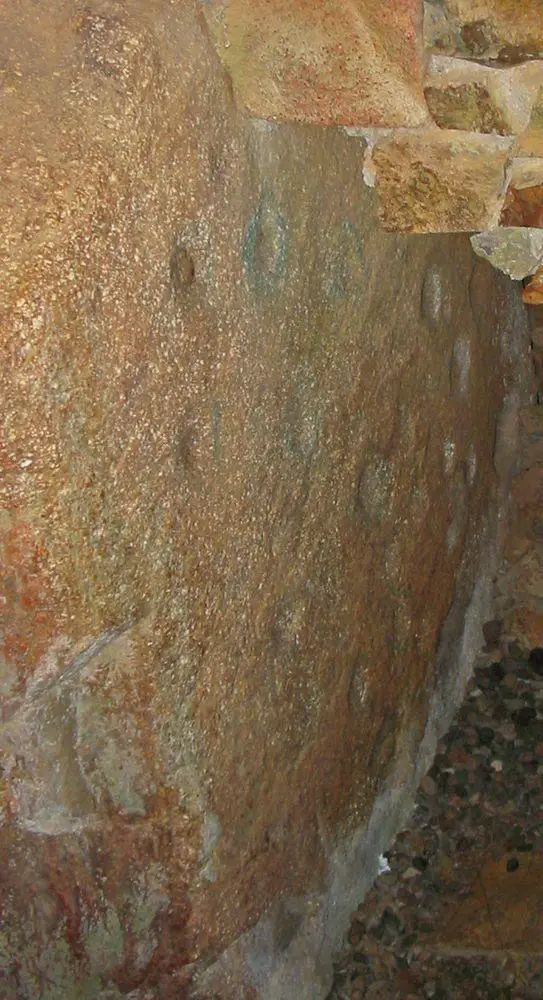
This astronomical orientation of megalithic structure seems to be linked to the fact that in Neolithic Age first farmers lived here. Subsistence on farming was risky in these times: every mistake and failure of early farmers led to inevitable hunger. Due to this, the observations of seasons and natural cycles was of utmost, truly religious importance.
Stone with cupmarks
4000 BC is very very long ago. But it is possible that La Hougue Bie contains evidence of older shrines.
One of the upright stones forming the walls of the northern chamber contains at least 24 deep cupmarks. The stone is located in such a way that some cupmarks are hidden – these cupmarks were of no special importance to the builders of the passage.
Thus it is possible that the current La Hougue Bie passage grave is built in the site of an even older shrine. The stone with cupmarks from this eventual older shrine was taken and used as a building material.
References
- La Hougue Bie, Megalithics. Accessed in the 31st March 2011. Extensive description!
- Images taken at spring equinox: Spring equinox at La Hougue bie, BBC. Accessed in the 31st March 2011
 Linked articles
Linked articles
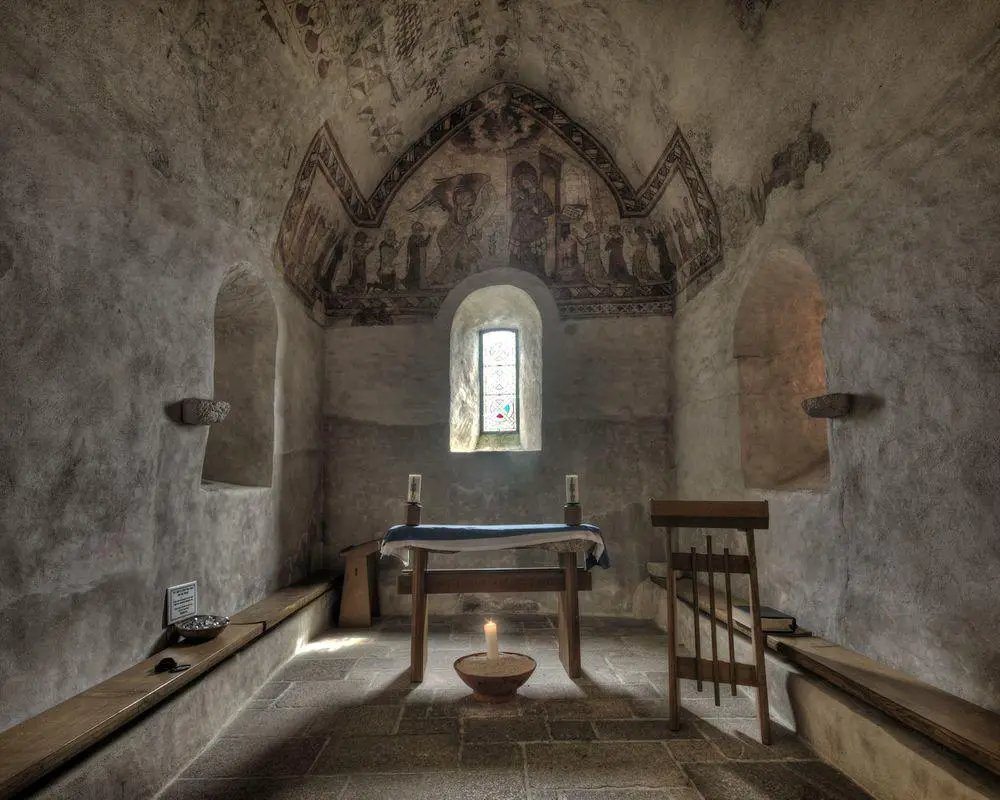
Wonders of Jersey
The small island of Jersey is very rich with archaeological heritage, but here are found impressive castles, amazing formations of the sea coast, numerous beautiful gardens, and other interesting attractions as well.
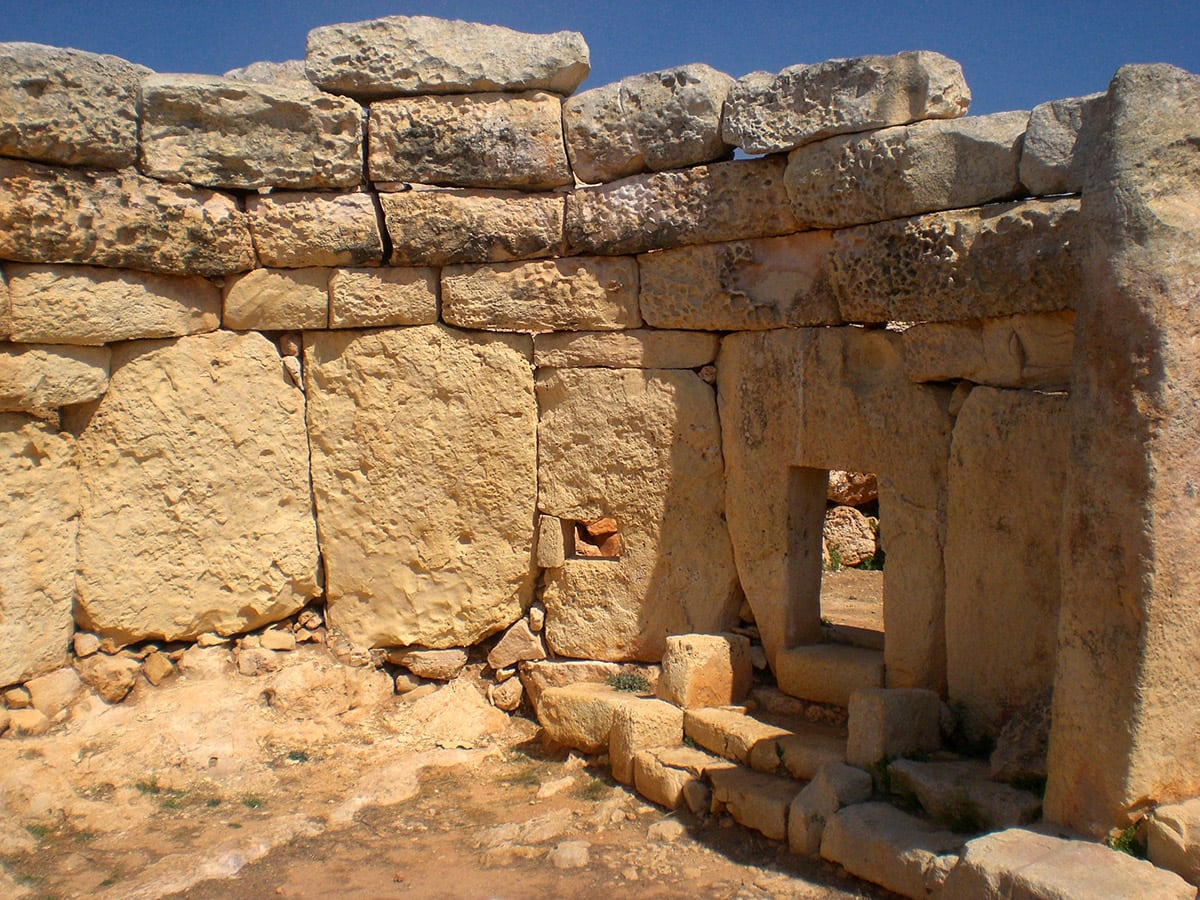
Megaliths
One of the most fascinating groups of archaeological monuments are prehistoric structures made of stones – megaliths. Through the ages, people have loved to strain their minds to find a sensible explanation for the many riddles posed by megaliths.
Even today, we can admit with some pleasure, there are thousands of mysteries left for us.

Wonders of Europe
The heritage of Europe is diverse and endlessly interesting. Incomparably rich is the wealth of European historical architecture, but this part of the world has exciting natural heritage and archaeological heritage as well.
 Recommended books
Recommended books
Jersey Legends
With fairies and dragons, witches, and werewolves, the picturesque island of Jersey boasts legends as varied and powerful as any within the British Isles. From its golden beaches to its treacherous cliffs, Jersey is alive with mysterious stories as strange and fascinating as the beings that inhabit them. This unique anthology includes the most famous of Jersey’s fables, such as the Hougue Bie Dragon, the Witches of Rocqueberg, and the demon of Bonne Nuit.
The “Time Team” Guide to the Archaeological Sites of Britain and Ireland
Channel 4’s perennially popular Time Team takes us on an archaeological sight-seeing tour of Britain and Ireland. Region by region, they select the most interesting and important sites which are open to public visitors, some familiar to all, others relatively unknown.


